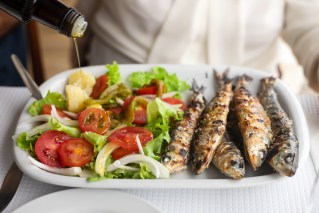Hayden Quinn’s adventurous new flavours


Allen and Unwin
The handsome, cheery surfer and lifeguard with the floppy blonde hair was a favourite to take out the title, but found himself on the chopping block prematurely.
With his trademark Aussie pluck, the 25-year-old picked himself up and refused to fade into the background, trading lifeguarding for full-time cooking, winning the title of Cleo Bachelor of the Year in 2012 and, now, releasing his debut cookbook, Dish It Up.
The daunting task of translating his love for food to the page didn’t faze the confident Sydney-sider.
“The hardest thing with this book was coming up with the title to be honest,” Quinn admits.
This is most likely due to the largely multicultural slant of the recipes and Quinn’s extensive travel experience.
“The travel element is definitely reflected in the book,” he says. “I’ve been to about 22 countries so far.”
This love for culture is reflected in Dish It Up, with everything from falafels, to Bánh mì, to the classic Aussie pie.
“I’ll eat almost anything,” he laughs. “I’m adventurous.”
He’s not kidding. While he cites his best food experience as “eating moules frites in the North of France with my best mate and a glass of wine,” he has also nearly died from eating a dodgy oyster in Australia, and has sampled dried worms in South Africa.
So where does the brave foodie draw the line?
“I wouldn’t have just a straight glass of milk,” he admits. “My girlfriend grew up on a dairy farm and she just drinks it no dramas. I don’t get it.”
Clearly, the Masterchef ladies favorite and Bachelor of the Year is a bachelor no longer.

Asian Crab Salad in Betel Leaves.
Asian crab salad
“This is the perfect summer party starter,” Quinn says. “It’s fun, light and sophisticated with some elegant flavours.” While he admits it may be difficult to find the betel leaves, the search will definitely be worth it. Alternatively, Quinn advises substituting perilla leaves, which he grows in his own garden.
1 tablespoon fish sauce
2 tablespoons light soy sauce 1 teaspoon peanut oil
11/2 teaspoons caster (superfine) sugar
1 bird’s eye chilli, sliced
1 long red chilli, halved, seeded and thinly sliced, plus extra to serve
1 carrot, julienned
2 red Asian shallots, thinly sliced
60 g (21⁄4 oz/1/2 cup) bean sprouts 1 cup (firmly packed) small mint leaves
1 cup (firmly packed) small coriander (cilantro) leaves 2 kaffir lime leaves, finely shredded, reserving some for garnish
21/2 tablespoons roasted peanuts, crushed, plus extra, to serve
small, young betel leaves (or perilla leaves) (see note), to serve
Dispatch the crab humanely (see note). Drop the crabs into a large saucepan of salted boiling water over high heat. Once the water returns to the boil, cook for 10 minutes, then remove the crabs and immediately refresh them in iced water. Break open the shells using the back of a large knife or a crab cracker.
Remove the crabmeat, shredding the meat slightly with your fingers. Make sure you remove any bits of shell or cartilage from the meat. Refrigerate until needed.
Whisk together the lime juice, fish sauce, soy sauce, peanut oil, sugar and bird’s eye chilli. Check the seasoning. You want salty, spicy, sour and sweet, adjust with any of the above ingredients to get it just right. Set aside until needed.
Place the crabmeat, red chilli, carrot, shallots, bean sprouts, mint leaves, coriander leaves, kaffir lime leaves and roasted peanuts into a large stainless steel bowl and toss gently together with the dressing. Lay out the betel leaves on a serving dish and spoon the crab salad onto the centre of the leaves, then garnish with the reserved shredded kaffir lime leaves, and the extra chilli and crushed peanuts.
Notes
- Best practice for humanely dispatching a crab is to place the live crab in the freezer for approximately 45 minutes until it is asleep. Make sure you haven’t frozen the flesh, but the crab should no longer be moving. Once chilled, the crab should be dispatched quickly by either immediately placing it into rapidly boiling water (as in this recipe) or by sectioning the crab with a sharp knife or cleaver.
- Betel leaves are dark green, glossy, heart-shaped leaves and can be found at Asian grocers. Look for medium to small leaves, rather than the larger ones which can tend to be tough. Perilla leaves are large fragrant leaves that are dark green and purple in colour. They’re also known as shiso leaves in Japanese cooking.
DIY pad Thai

Pad Thai pops with vibrant flavours.
This perennial favourite is a recipe inspired by Quinn’s best mate, Tim. “It tells a bit of a story of his time in Bangkok and how he’d had a few beers and wanted to get amongst the pad Thai. He bartered his way behind a wok and got into it.” Quinn’s aversion to takeaway food (“I never order it unless I’m incredibly hungover”) also inspired him to create a healthier, at-home alternative of the dish most people order in.
400 g (14 oz) chicken thigh fillet, thinly sliced
2 tablespoons tamarind purée 11⁄2 tablespoons lemon juice
2 tablespoons fish sauce
90 g (31/4 oz/1⁄2 cup) finely chopped palm sugar (jaggery) 3 red Asian shallots, thinly sliced
2 free-range eggs, lightly beaten 2 tablespoons dried shrimp, soaked in warm water, drained
320 g (111/4 oz) packet hard stir-fry tofu, cut into 2 cm (3/4 inch) pieces
2 bird’s eye chillies, thinly sliced 2 tablespoons finely chopped peanuts, plus extra, to serve 2 spring onions (scallions), thinly sliced on the diagonal, plus extra to serve
115 g (4 oz/1 cup) bean sprouts 1⁄2 cup coriander (cilantro) leaves, plus extra to serve lemon wedges, to serve
Soak the rice stick noodles in cold water for 5 minutes, then blanch in
a saucepan of boiling water for 2 minutes or until almost cooked. Drain.
Meanwhile, heat 2 tablespoons of the peanut oil in a large wok over high heat. Add the chicken and cook, stir-frying for 5 minutes or until browned and cooked through. Transfer to a plate and wipe out the wok with paper towel ready to be used later.
Place the tamarind, lemon juice, fish sauce and palm sugar with 2 tablespoons water in a small bowl and whisk to combine.
Heat the remaining 60 ml (2 fl oz/1⁄4 cup) oil in reserved wok over high heat. Add the shallots and stir-fry for 2 minutes or until light golden. Add the eggs and continue to cook for 11⁄2 minutes or until the egg begins to set like an omelette. Add the drained noodles and stir-fry for 2 minutes or until the egg has broken up. Stir in the palm sugar mixture and stir-fry for a further 3 minutes or until the mixture is syrupy and sticking to the noodles. Add the chicken with the remaining ingredients and stir-fry for a further 2 minutes or until the tofu and chicken is heated through. Pad Thai should be sweet, sour and salty.
To serve, divide among plates and scatter over the extra spring onions, coriander and peanuts and a squeeze of lemon.
Notes
- If the mixture is too dry, add 1 tablespoon of water at a time before you finish stir- frying until you reach your desired consistency.
- Substitute chicken with green king prawns (shrimp) or for vegetarian options, omit the dried shrimp, fish sauce and add some more tofu.
Nasi Goreng

Nasi Goreng is as a staple for Australian surfers in Indonesia.
Quinn describes this Indonesian rice dish as “a staple for Australian surfers who have visited the Indonesian Islands,” fondly recalling his own surfing trips where this was the breakfast of choice. “The one thing I love about travel is the breakfast food is often nothing like what you would expect,” Quinn says. “That’s exciting. Nasi Goreng is something you can eat any time of the day.”
2 cm (3/4 inch) piece ginger, julienned
2 garlic cloves, thinly sliced 2 teaspoons tomato sauce 1 teaspoon tamarind puree (see note)
2 tablespoons kecap manis 2 tablespoons sambal oelek (chilli sauce)
1 tablespoons grated palm sugar or brown sugar 600 g (1 lb 5 oz/31/4 cups) cooked long-grain white rice (see note)
2 small tomatoes, roughly chopped
350 g (12 oz/2 cups) finely shredded barbecue chicken to serve spring onion (scallion), thinly sliced 1 chilli, sliced
fried Asian shallots
Heat 2 tablespoons of the peanut oil in a non-stick frying pan over medium– high heat. Crack the eggs into the pan, one at a time and fry for 3 minutes for sunny side up or until cooked to your liking. Transfer to a plate and set aside until needed.
Heat the remaining oil in a large wok over high heat. Add the shallots, ginger and garlic and stir-fry for 3 minutes or until the shallots and garlic are light golden in colour.
Reduce the heat to medium. Stir in the tomato sauce, tamarind puree, kecap manis, sambal oelek and palm sugar. Cook, stirring occasionally, for 2 minutes or until combined and the sugar has dissolved.
Using your hands, scatter over the rice (breaking up any lumps) then the tomatoes and chicken. Stir-fry for 5 minutes or until the rice gains a little colour and is heated through.
Divide the nasi goreng among the bowls, top with the fried eggs and scatter with onions, sliced chilli and fried Asian shallots. You can add a wedge of lettuce to the bowl and serve with prawn crackers and bean sprouts.
Notes
- Tamarind purée is available from selected supermarkets and Asian grocers. Substitute with a tablespoon of lemon juice.
- It is best to use one-day-old rice when stir-frying. This will ensure your fried rice does not become gluggy and overcooked. If using freshly cooked rice, cool on a flat tray
in the refrigerator, stirring occasionally, before stir-frying. - Substitute chicken for prawns (shrimp) or omit entirely for a vegetarian option. Prawn crackers are available at supermarkets and Asian grocers.
Dish It Up ($35) is available is available now through Allen and Unwin.









